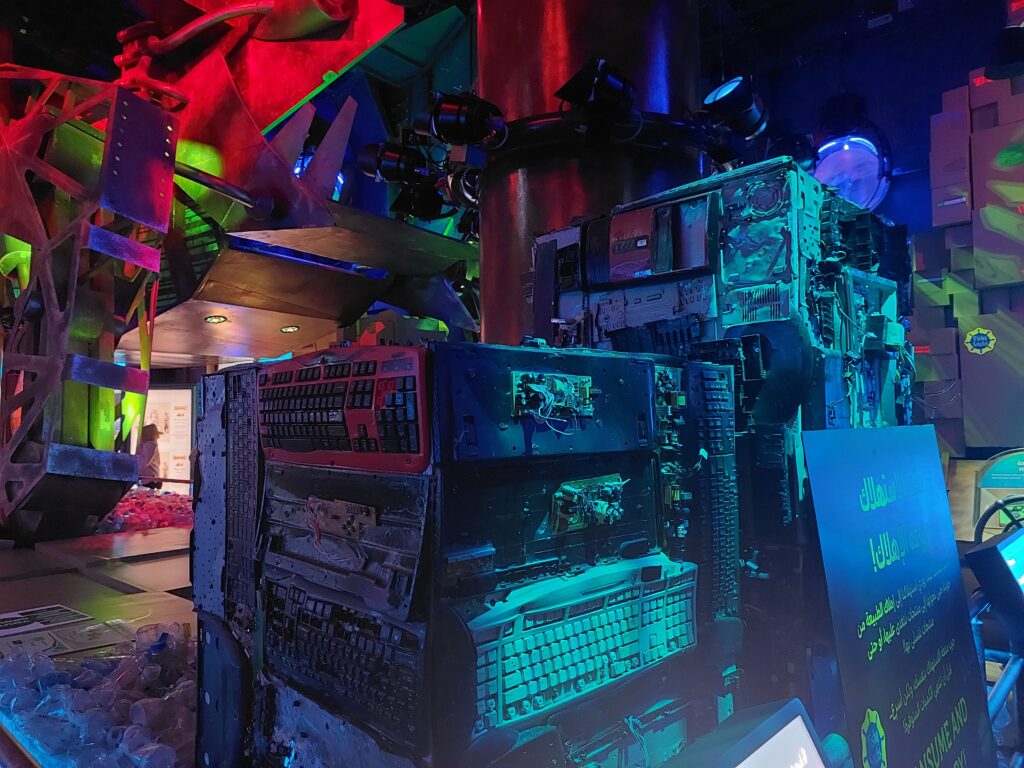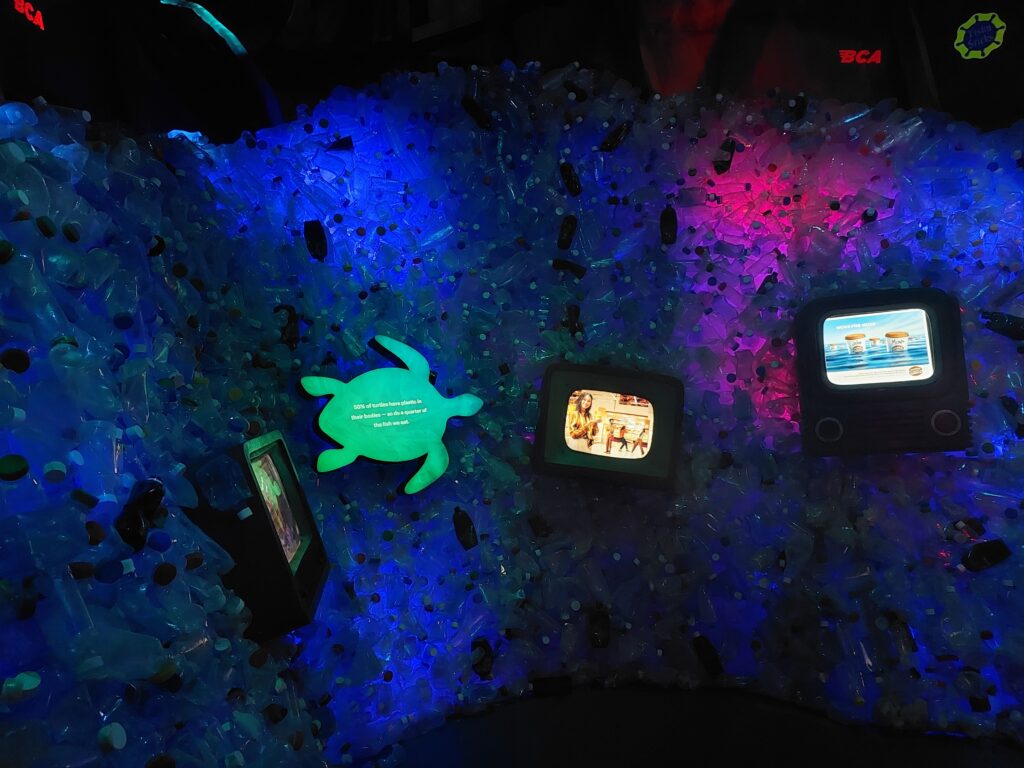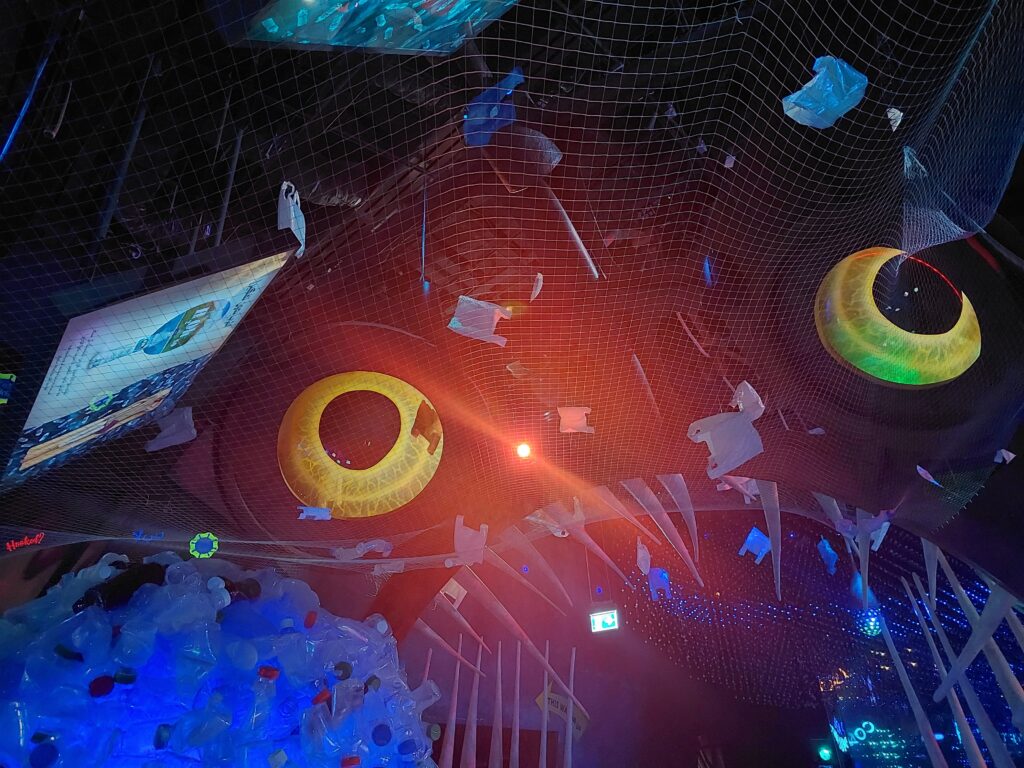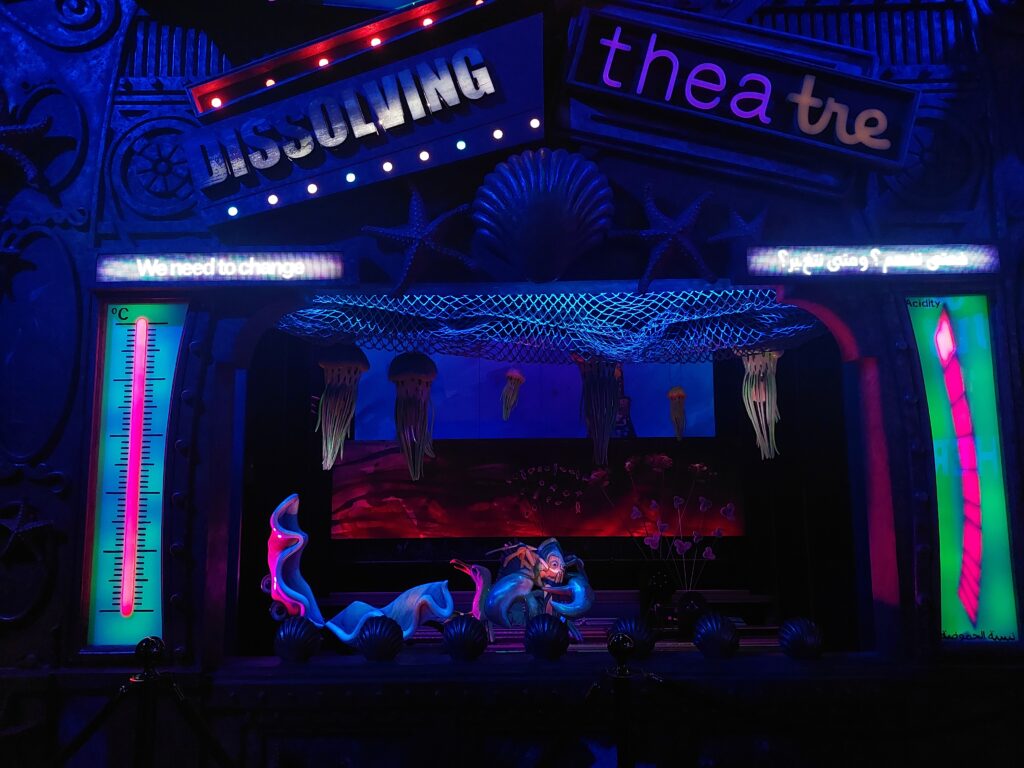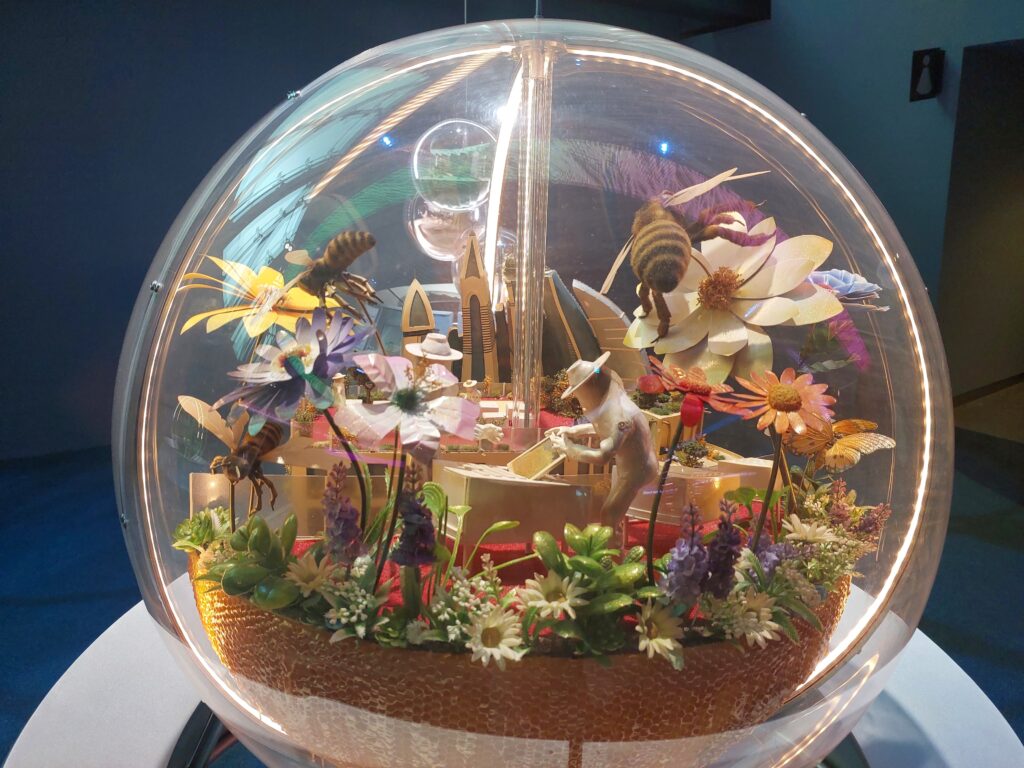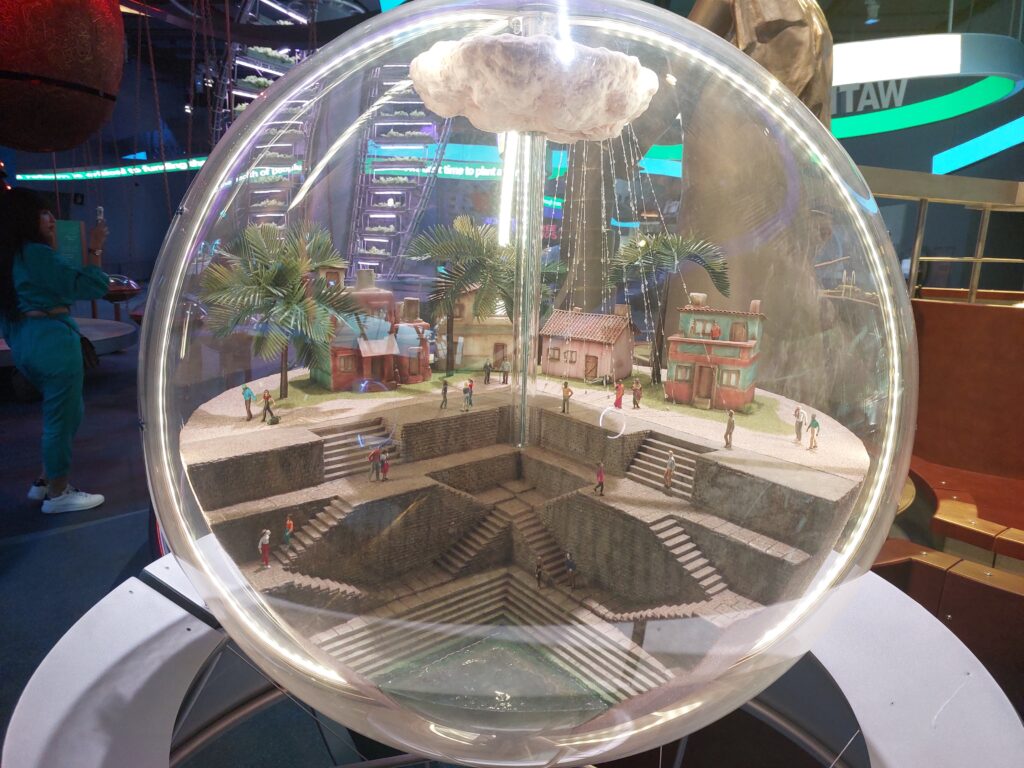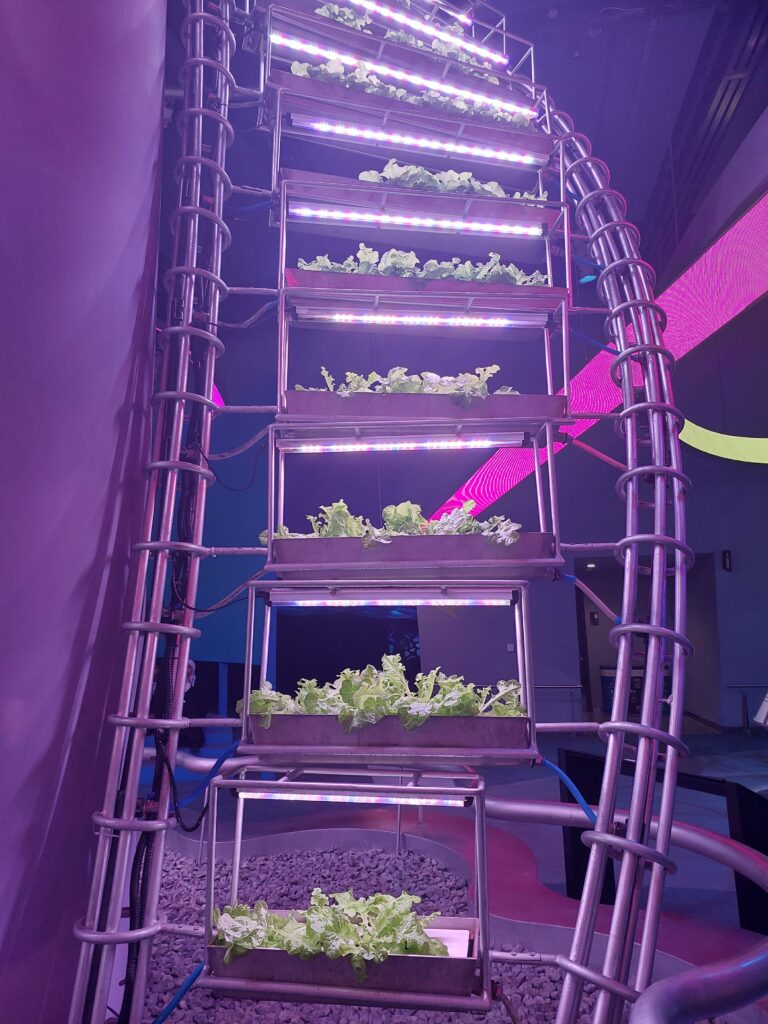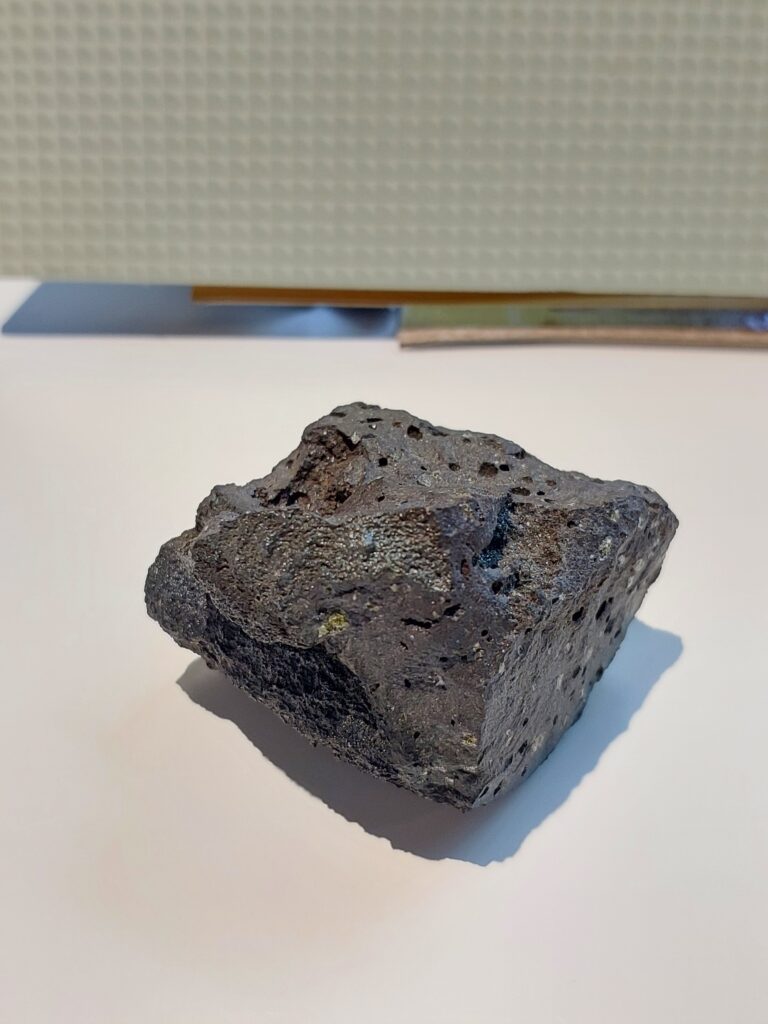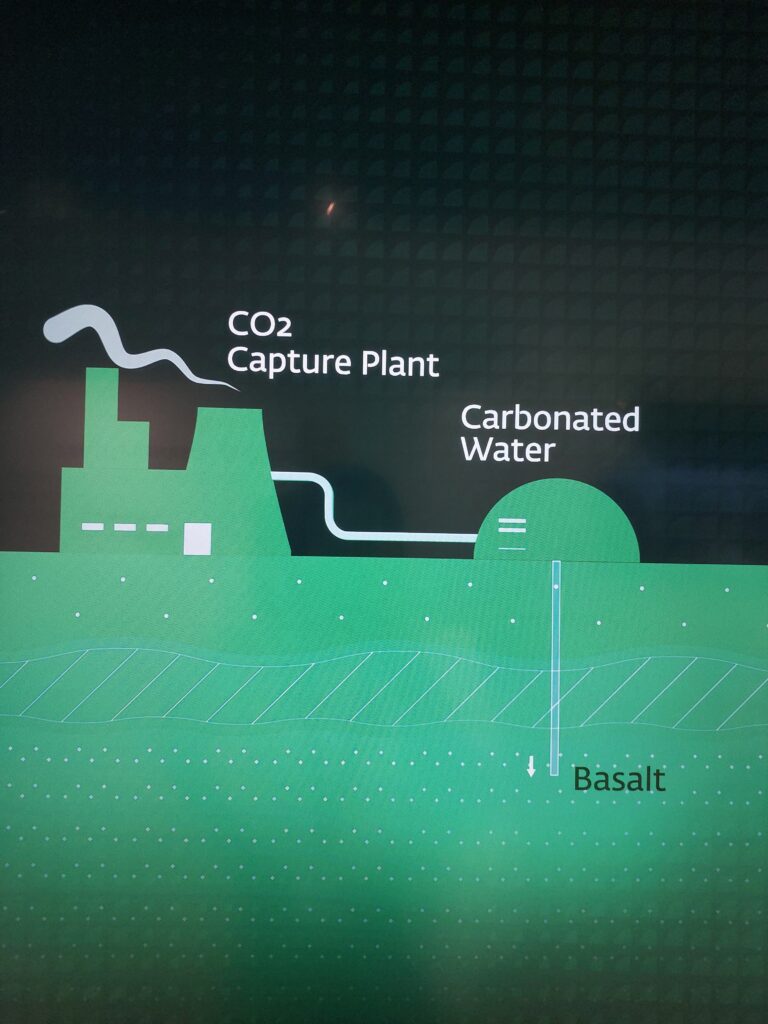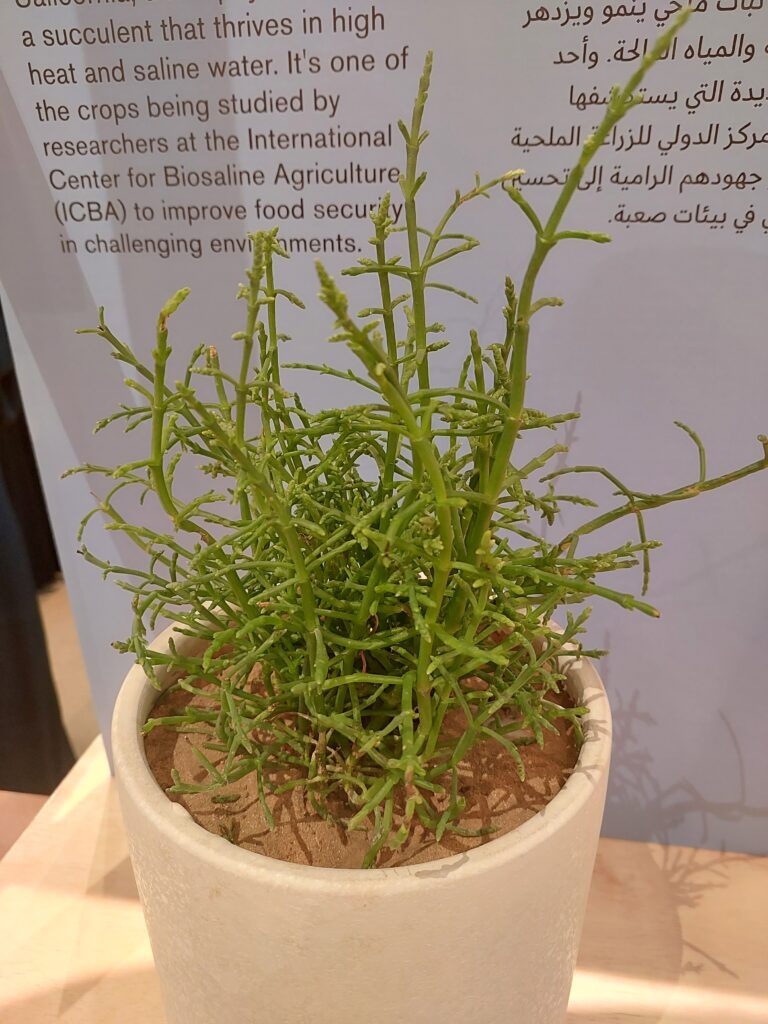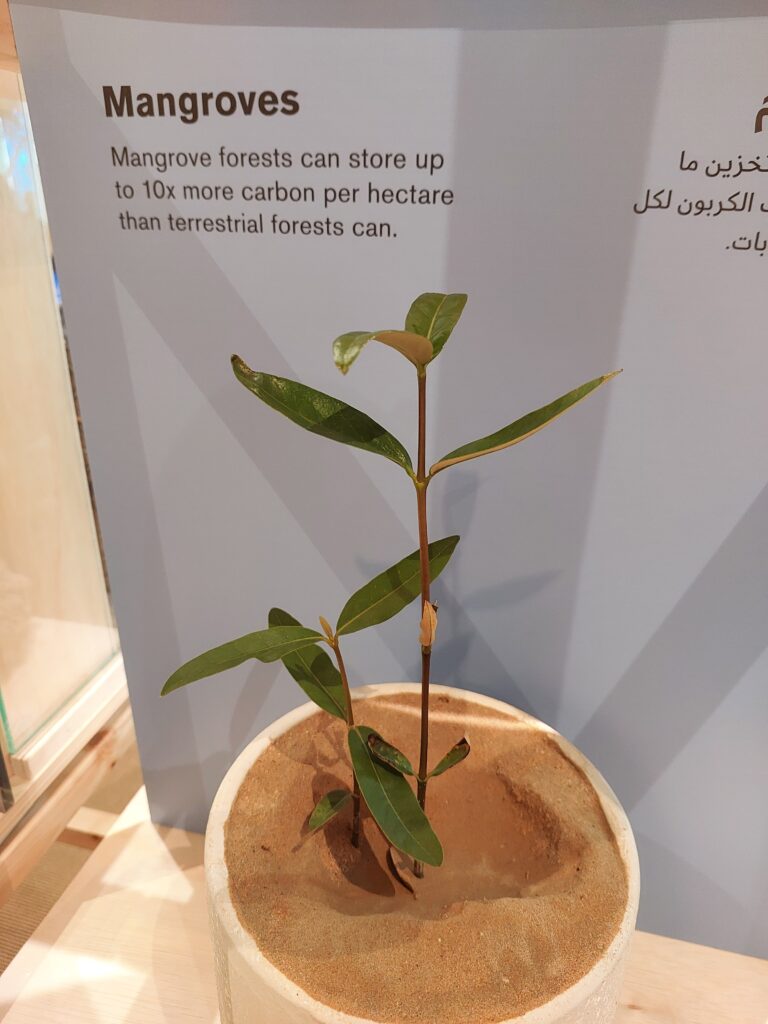By Jasmine Sone
Step into the captivating world of COP28 exhibitions, where ideas are showcased in brilliant shades of sustainability. The halls of COP28 were not merely places for debate but also galleries of inspiration, with collections that echoed the heartbeat of our planet’s future. The vivid and inventive displays across the Blue and Green Zones urged exploration, each promising a different insight into our sustainable future. These exhibitions, which ranged from interactive displays to thought-provoking installations, excited my curiosity and made a lasting impression on my COP28 experience. Join me as I go into the enthralling world of exhibits that graced this worldwide event, revealing the most fascinating and engaging displays I’ve seen and delving into a universe where creativity meets sustainability.
The Pollution Pods
To start the blog, I will highlight the Pollution Pods, my favorite exhibit at the event. These geodesic domes, created by British artist Michael Pinsky, are more than just beautiful—they provide an immersive experience unlike any other. Visitors can safely experience air pollution from three cities within these domes: Beijing, London, and New Delhi. Furthermore, the fourth pod emphasizes solutions for cleaner air and allows visitors to look up air pollution data from cities worldwide. Each dome precisely recreates certain types and degrees of air pollution, allowing participants to feel, taste, and even smell the prevalent environments for a significant percentage of the global population. These Pollution Pods, supported by the Clean Air Fund and Breathe Cities, serve as a striking proof of the realities of air pollution while advocating for practical solutions.

Before going into the immersive experience of the Pollution Pods, I spoke briefly with Regina Zhyldyzbekava, one of the exhibit representatives. Regina suggested beginning in the London dome, moving on to New Delhi, and lastly to Beijing. One thing that Regina mentioned stuck with me before I went inside was the artist’s meticulous attention to detail, attempting to recreate not only the temperature and visibility of these places but also their distinct odors. For example, the artist used vinegar to capture the aroma of sulfur dioxide prevalent in New Delhi (typically caused by the combustion of coal and fossil fuels). So, remembering everything she had said, I followed her advice and dove in, ready to enjoy the multi-sensory adventure.
I could feel the cool air as soon as I entered the London dome. But it wasn’t just that; a distinct smokey, oily smell reminded me of tar. A nearby computer panel displayed nitrogen dioxide as the primary pollutant, while two black machines labeled diesel and tar confirmed the scents I was experiencing.
Things changed substantially when I moved to New Delhi. The visibility took a bit of a hit in there. I could still make out objects and figures, but everything became somewhat hazy. The air also got hotter, and I started feeling suffocated after just a few moments. My throat even became slightly parched. Regina was spot on—the air had a sourness to it, with a whiff of heated plastic (you know, that unmistakable smell when plastic is burning).
Then came Beijing. Talk about a contrast! Visibility plunged into a blur, surprising me, yet the temperature was similar to that of London. There was a faint sourness to the air, similar to New Delhi’s, but with a whiff of smoke, as if something was burning nearby. Particulate matter (PM) led pollution readings, as it did in New Delhi, followed by sulfur dioxide, nitrogen dioxide, and ozone—all at similar levels.
Phew! What a relief to step out of those domes, away from the sour, burning smells, and finally regain clear vision.
Stepping into those domes’ heart of severe air pollution was a wake-up call. It was a startling realization: our world is on the verge of devolving into a dystopian nightmare. Imagine this—you’re fighting for every breath, your vision is clouded into a murky haze, and the air is thick with an overwhelming sense of hopelessness. The weight of that reality stirred a whirlwind of emotions—fear, a frightening dread of what will happen if we don’t act quickly; grief, a sting of knowing that millions of people experience these horrible conditions every day; and rage, a simmering sense of injustice for people whom this environmental assault has hit the most.
That unsettling truth stayed as I stepped away from the Pollution Pods—it’s not some distant prophecy; it’s happening right now in countless corners of our planet. The need to address air pollution has become more pressing than ever. It was a cry to arms, a renewed determination to strive for change because, in the end, the fight against air pollution affects us all—it’s a struggle we must win together.
Terra—The Sustainability Pavilion

Terra—The Sustainability Pavilion was an absolute blast to explore within the Green Zone. It’s a haven full of immersive activities designed for people of all ages, especially children, to take them on a meaningful journey toward understanding their environmental impacts while inspiring them to form a better tomorrow.
This LEED (Leadership in Energy and Environmental Design) Platinum Certified eco-friendly pavilion has spectacular architecture, including a large 120-meter canopy and 18 Energy Trees that generate 4GWh of alternative energy yearly. The canopy is not just visually appealing; it also collects rainwater via subsurface reservoirs for use in cooling systems.

As I stepped into the pavilion, the journey unfolded. Intriguing displays and statues along the circling path demonstrated how the country’s ancestors sustainably flourished in the desert. They artistically illustrated many habitats, animals, and more. The narrative gradually took a visual turn, with a captivating line chart demonstrating the influence of human actions on climate change, signifying a turning moment.
I eventually arrived in a large open room with an arcade—a lively hub bustling with interactive games. It wasn’t just about having fun; each game also served as an educational tool, teaching visitors of all ages important information. The combination of entertainment and education effectively embodied Terra’s essence, enabling everyone to learn and connect with sustainability in a fun and instructive way.
Exiting the arcade, I enter a new zone with two entrances: “Under the Forest” and “Under the Ocean.” Naturally, I had to explore both! I went first into the “Under the Forest” section. I felt like I’d been transported to the center of a forest the instant I stepped inside. The ceilings were covered in roots, providing a dim, gloomy light occasionally lit by colored lights that guided me around the displays. Along the way, informative signs highlighted the significance of what lies beneath the forest floor—why forests and the intricate underground ecosystems featuring elements like soil, fungi networks, and critical decomposers like worms, are important and warrant protection.

Following that, I enter the “Hall of Consumption,” an eye-opening space highlighting our consumption habits and the immense damage they cause. The displays were alarming and thought-provoking, with stacked plastic bottles, discarded technology such as keyboards and smartphones, and a large wardrobe demonstrating the staggering 2,700 gallons of water necessary to manufacture a single cotton T-shirt. As if that wasn’t shocking enough, the exhibit displayed an endless refrigerator, displaying disturbing data such as the tragic waste of 12 billion animals as discarded meat each year and the mind-boggling number that the food we throw away could feed about 4 billion people yearly.
Another attractive section within the “Hall of Consumption” was the “Would You Rather” segment, which gave visitors two options. Following their choices, visitors were given information on whether or not their choice was compatible with sustainable practices. It was a fun way to engage visitors and foster introspection about our purchasing habits.
“Under the Ocean” showcases the ocean’s wonders and importance, much like the “Under the Forest” exhibit.

I was captivated by the deep ocean representation with twinkling lights—it was breathtaking!

Similar to the forest section, the “Sea of Consumption” displayed a wall of plastic bottles, vividly depicting the harm to aquatic life. Plastic bags dangling from the ceiling further captured the ocean environment, and the attention to detail was impressive. The exhibition also included a ‘Dissolving Theater,’ demonstrating how ocean acidification destroys marine life—a truly impactful experience.
The “Would You Rather” segment in this exhibit presented different questions than those in the “Under the Forest” display. While waiting in line at one of the stations, I witnessed a remarkable moment that left a lasting impression. A young boy stood in front of the interactive station. After much thinking, he chose both options presented in the question. Curious about his choice, I realized it was a rather profound decision once I saw the question: “Would you rather always have clean air to breathe or always have clean water to drink?” This moment struck a chord within me. I assumed I could only choose one option because it was a ‘Would You Rather’ game. But seeing the kid choose both ‘clean air and water’ opened my eyes to embracing multiple possibilities and the imaginative thinking of the younger generation. There’s so much to learn from the youth’s open-mindedness, no matter how young they are.
Exiting the captivating “Under the Forest” and “Under the Ocean” sections, I find myself in another hall—The Laboratory of Future Values. Here, solutions to pressing problems about our future and the well-being of our planet were ingeniously depicted. Each solution, depicted by tiny figurines within little globes, portrayed initiatives such as supporting pollinators, embracing circular economies, rainwater harvesting, conserving keystone species, and more. The level of detail in these figurines was absolutely amazing! Not to mention that they were really adorable. Sadly, I couldn’t find the name of the artist(s) behind these fantastic works, but I’d love to take a moment to applaud their exceptional craftsmanship.
Moving from this marvel, the journey led to the final hall, where Mat Collishaw‘s “Equinox” takes center stage. This 3D zoetrope, an optical illusion, artfully contemplates the delicate balance of Earth’s ecosystems. Accompanying this masterpiece, William Blake‘s words from his poem “Auguries of Innocence,” “To see a World in a Grain of Sand/ And a Heaven in a Wild Flower/ Hold Infinity in the palm of your hand/ And Eternity in an hour,” decorate the walls in both English and Arabic.

In this immersive experience, as Blake’s profound line suggests, even the smallest components in our world—a grain of sand, a wildflower—hold deeper cosmic truths when seen with the correct energy and imagination. It’s a reminder that every effort, no matter how tiny, can make a huge difference in sustainability and the challenges of climate change. These seemingly little aspects can lead to substantial transformations for the future of our world through collective imagination and commitment.
Saudi Arabia and UAE Pavilions
In the Blue and Green Zones, I had the fantastic opportunity to explore pavilions representing many nations. While most attendees concentrated on talks and interactive discussions with booth personnel, two countries stood out for their impressive exhibits: Saudi Arabia and the United Arab Emirates (UAE). Their displays were excellent, as were their interior designs.
Saudi Arabia’s pavilion was stunning, with lush flora adorning the walls. The luscious setting aligned perfectly with their Saudi Green Initiative. I just love what they did with their interior design—so green and refreshing!
The UAE pavilion, on the other hand, was minimalist in design, with mostly white walls, tapestries, and furnishings in beige tones. The theme’s simplicity was visually appealing, brilliantly expressing the UAE’s dedication to returning to roots and taking lessons in sustainable living from ancestors’ resourcefulness. The UAE’s exhibitions and smart interior design choices emphasized nature-centric solutions and intimate links with the environment.
And here’s a fun tidbit—each country’s pavilion had its own distinct scent! The Saudi Arabia and UAE pavilions were among the most fragrant.
The CO2 mineralization in basalt in Saudi Arabia’s exhibit immediately drew my attention. Situated in the Blue Zone, this KAUST project investigates subsurface CO2 mineralization in basaltic rocks. Their method entails absorbing atmospheric CO2 and converting it to liquid before storing it safely in basalt beneath the earth’s surface. They claim it is a safe and cost-effective solution for CO2 sequestration.
Moving to the Green Zone, the Green Mosque Initiative piqued my interest. This initiative by the Vegetation Cover Development Foundation (Morooj) focuses on recovering and treating greywater created by ablution water in mosques. It is being repurposed for gardening and developing playgrounds near mosques.


These initiatives are truly innovative and groundbreaking! While there were many other outstanding initiatives, these two stuck out to me the most.
Moving on, one of the more notable UAE projects that drew my attention was the cultivation of salicornia. This halophytic crop, which thrives in high temperatures and salinity, represents a possible adaptive strategy in the face of climate change. Such plants can improve food security under challenging locations while matching the changing climate landscape.
Another noteworthy initiative centered around mangrove conservation. These coastal forests are effective nature-based solutions to climate change, storing up to ten times more carbon than their terrestrial counterparts. Furthermore, mangroves serve as natural buffers against coastal erosion, protecting communities and ecosystems from the effects of increasing sea levels. Through the Mangrove Alliance for Climate, the UAE has committed to planting 100 million mangroves by 2030 in collaboration with Indonesia.
Lastly, while not an initiative per se, the barjeel stands out as a unique heritage cooling technique used for over a century. This clever design takes in outside air, filters it through moistened cloth, and brings the cooler, damp air inside, displacing the warmer air. It not only exudes cultural charm but also offers a sustainable solution for temperature regulation.
These were just a few of UAE’s noteworthy projects, all showcased in the Blue Zone, that resonated with me. They are examples of unique sustainability approaches among many efforts.
The journey through COP28’s exhibits was nothing short of a rollercoaster, revealing the stark reality of our environmental concerns and the fantastic innovations poised to address them. Each display was a chapter in our joint pursuit for a greener world, from the immersive experience of the Pollution Pods to the unprecedented leaps shown in the Saudi Arabia and UAE pavilions.
But amid the frenzy of exhibits and incredible innovations, a heartwarming sight stayed with me. Witnessing children’s eyes light up with newfound knowledge and actively discussing sustainability with their parents as they exited the exhibits gave me hope. Their excitement, determination, and passionate hearts made me smile. It’s a reminder not just of the urgent need for immediate, inclusive, and equitable environmental action but also of the enduring hope they embody and the immense power of collective determination in reshaping our world.






